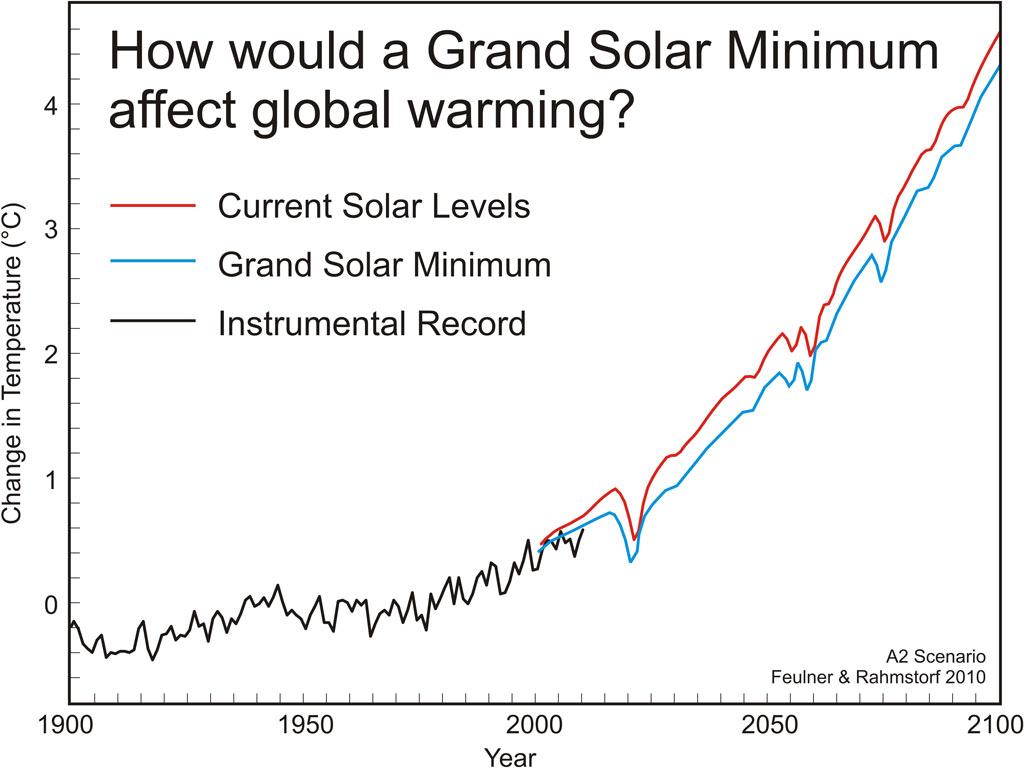
In September, a website called Space Weather Archive interviewed Martin Mlynczak of NASA’s Langley Research Center. Mlynczak noted that because the sun is currently in a relatively inactive period, the thermosphere (one of the highest layers of Earth’s atmosphere, more than 300 miles above the surface) could reach its coldest temperatures since records began in the 1940s.
The interview didn’t mention Earth’s surface temperatures, where the past five years have been the five hottest since records began in the late-1800s. However, the British newspaper Metro then ran a story falsely claiming that: “It’s feared this could herald the arrival of a uniquely grim ‘mini Ice Age.’ ”
Like a bad game of Telephone, this inaccurate reporting then spread throughout the conservative media, including Fox News, the Drudge Report, Rush Limbaugh, and Sarah Palin’s Twitter page. The story was debunked by the climate scientists at Climate Feedback, and Metro subsequently issued a correction, but the damage had been done.
The ‘imminent mini ice age’ myth rears its ugly head in the conservative media like clockwork every year or two. It’s always based on claims that the sun is headed into an inactive phase, like those that coincided with what has popularly been called the “Little Ice Age”—the period from roughly about the 16th to 19th centuries when some exceptionally cold winters made the Thames River sometimes freeze so solidly that Londoners held winter fairs on the ice, and contemporary diarists wrote that the snow was so deep in New Hampshire that people burned their furniture because they couldn’t get to the woodshed. (“…[O]ur last Winter brought with it a Snow that excelled them all,” wrote Cotton Mather wrote in his diary in 1717, under the heading “An Horrid Snow.”) But the term Little Ice Age is a misnomer, and some climate scientists have argued that the name should be abandoned. It was not a full-blown ice age at all (or even a little one), but rather a very short-lived and puny climate and social perturbation, by the standards of geologic time.
It’s true that the sun is in a relatively quiet period, with the amount of energy reaching the Earth (Total Solar Irradiance, or TSI) lower than it has been since the mid-1900s. But TSI is still significantly higher than it was during the so-called Little Ice Age, and likely higher than at any time between the 1600s and 1940, for that matter. Particularly during the late-1600s, there was a period when only about two sunspots were observed per year. (Sunspots are an indicator of solar activity). Scientists coined this type of period a “grand solar minimum.” For comparison, in 2018 there have been about 50 sunspots observed.
It remains an open question when another grand solar minimum could occur. Northumbria University mathematics professor Valentina Zharkova created a model that predicts the sun will enter another grand minimum phase lasting from about 2020 to 2055. But solar scientists have criticized this model as being overly simple and flawed. For example, Ilya Usoskin, head of the Oulu Cosmic Ray Station in Finland and vice-director of the country’s ReSoLVE Center of Excellence in Research, published a critique of Zharkova’s solar model, noting that it was created based on just 35 years of data and fails to accurately reproduce past solar activity. And if it cannot accurately reproduce past solar activity, then how can it be expected to accurately predict future activity?
In contrast to Zharkova’s findings, in a new paper just published in Nature Communications, solar scientists Prantika Bhowmik and Dibyendu Nandy at the Center of Excellence in Space Sciences, India, created a model that successfully reproduced the sun’s cycles back to the 1930s–more than double the number of years (and data points) used in Zharkova’s troubled model. Based on a longer timeline and our understanding of the sun’s physics, their model predicts that the next 11-year solar cycle (between about 2019 and 2030) will be relatively quiet, similar to the current one, but it will still be much more active than during previous grand solar minimum events.
I spoke with Ilya Usoskin, who was not involved in the research of Bhowmik and Nandy but finds their results to be credible, based as they are on a physical model driven by observational data. Usokin noted that the next 11-year solar cycle can generally be modeled reasonably accurately once the minimum of the current cycle is approached. But later solar cycles beyond the year 2030 cannot be reliably predicted now, before the minimum of the next solar cycle, because of the more random and unpredictable component of solar activity.

The global mean surface temperature difference under the IPCC A2 emissions scenario (close to our current greenhouse gas emissions pathway) under the current level of solar activity (red) and in a grand solar minimum (blue), with NASA Goddard Institute for Space Studies measurements (black). Adapted from Fuelner & Rahmstorf (2010) by SkepticalScience.com
Research has also shown that global average surface temperatures only cooled by about 0.5 degrees Celsius during the Little Ice Age. For comparison, temperatures have risen 1 degree Celsius over the past century due to human-caused global warming. If the prior period was a little ice age, then the current period is a Big Warming Age.
Posted by dana1981 on Tuesday, 18 December, 2018
 |
The Skeptical Science website by Skeptical Science is licensed under a Creative Commons Attribution 3.0 Unported License. |